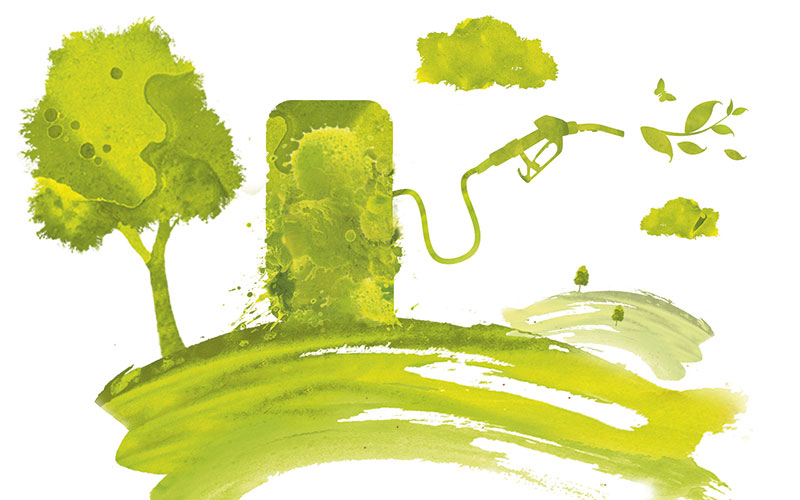Reinventing refineries
The transition to a low-carbon economy will require downstream organisations to invest in low-carbon technologies. EIC analyst Tayo Idowu looks at the disruptive technologies transforming the downstream industry

Today, refining companies face a more challenging and convoluted market. The growth of electric vehicles, more efficient internal combustion engines, and the world’s transition to a low-carbon economy are driving down demand for oil products and ramping up carbon emissions cuts. The ongoing digital transformation being led by automation, analytics and artificial intelligence is also having a profound impact on downstream operations.
In order to stay competitive against this backdrop, companies must adopt low-carbon strategies that account for demand trends and fundamental shifts in regulation, as well as leveraging digital innovation. Using more sustainable feedstocks and looking to disruptive decarbonising technologies will be essential to long-term profitability, but companies will need to consider when to more fully embrace these opportunities while managing the changing risks. The industry has a clear role in the energy transition. While decarbonisation can seem complex, several solutions are evolving – biofuels from waste, carbon capture, utilisation and storage (CCUS), crude oil-to-chemicals (COTC) and hydrogen.
Biofuels from waste
Biofuels are liquid or gaseous fuels derived from waste biomass rather than from fossil fuels. With their renewable nature, advanced biofuels have an important role in reducing greenhouse gas emissions from the transport sector. They also provide a practical alternative to fossil fuels for aviation, shipping and heavy freight trucks.
Aviation represents an emerging market. While sustainable aviation fuel is not a new concept, it has seen new urgency following the increasing efforts to tackle climate change. The most likely conversion technology for these advanced-bio-jet pathways will be thermochemical, instead of biochemical. This is because intermediate products derived from biochemical routes will probably fetch a higher price from buyers outside the aviation sector.
Having secured planning permission recently, the UK’s first green jet fuel refinery looks set for take-off in 2024.
Carbon Capture, Utilisation and Storage
CCUS is a critical emissions reduction technology that is capable of reducing carbon emissions along the life cycle of fossil fuels. Although it is not a new technology, large-scale investments are on the rise as ambition increases in the pursuit of net-zero energy system emissions.
There are three main approaches to carbon capture: pre-combustion capture, post-combustion capture and oxy-fuel combustion. The chosen technology depends on whether the facility is a new or retrofit plant. Other considerations include capital and operating costs.
In pre-combustion capture, steam reforming of the primary fuel produces a mixture of carbon monoxide and hydrogen. A shift reactor produces CO2 and additional hydrogen by reacting the synthetic gas with steam. This mixture of hydrogen and CO2 is then separated into their independent streams – the CO2 is sent to storage and hydrogen used for power generation.
Post-combustion capture involves the separation of CO2 from flue gas produced by the combustion of the primary fuel in air. It can be added to existing plants as a retrofit, which is one of the advantages.
Oxy-fuel combustion involves separating oxygen from the air and using it as an oxidant for fossil fuel combustion, which is the main difference from standard combustion. The fuel combusted in oxygen diluted with recycled flue gas rather than air produces final flue gases consisting mainly of CO2 and water – producing a more concentrated CO2 stream and making it easier for purification.
The total number of CCUS projects in industry and fuel transformation rose to 19 in 2020.
Crude oil-to-chemicals
As petrochemical demand is expected to increase, refiners and downstream players are looking to prioritise chemicals over fuel production. By targeting the integration of petrochemical production capability in one facility, COTC complexes can increase the scale of petrochemical production by five–10 times.
Although COTC will affect the global supply and demand for chemicals, it has the potential to improve margins.
Today, there are only a few operating COTC plants in the world. A number of projects are in the pipeline, located in Asia and the Middle East.
Hydrogen
Hydrogen is a non-toxic colourless gas obtained through a carbon-intensive or low-carbon route. Depending on the production process, hydrogen is classified as either grey, blue or green.
Grey hydrogen is produced via the steam reforming of natural gas or coal gasification.
During steam reforming, the methane from natural gas reacts with high-temperature steam in the presence of a catalyst. A water gas shift reaction follows, producing CO2 and hydrogen. One drawback of this production route is the release of CO2 into the atmosphere. This is where hydrogen production combined with CCUS provides an advantage.
Blue hydrogen is produced similarly to grey hydrogen, with the addition of carbon capture and storage. This form of production has the benefit of industrial-scale volumes of carbon-neutral hydrogen.
Green hydrogen is produced through electrolysis and involves the splitting of water. The electrolyser consists of a direct current (DC) source and two noble metal-coated electrodes, separated by an electrolyte. The current is applied to the cathode where the hydrogen is made and the electrons produced by the electrochemical reaction return to the positive terminal of the DC source to release oxygen. It can only be classified as green hydrogen if the electricity source comes from renewable forms of energy, such as wind and solar.
The blending of hydrogen into the existing natural gas pipeline network has the potential to help with the variable output from renewables. If implemented under appropriate conditions and at relatively low hydrogen concentrations (less than 5–15%), this strategy of storing and delivering energy may require only minor modifications to the operation and maintenance of the pipeline network.
Ammonia is another alternative, where its cracking can reproduce hydrogen closer to the end-user.
Governments, including those of Germany, the UK, Australia and Japan, are working on or have announced hydrogen strategies.
These technologies feature in greater detail in the latest EIC Downstream Insight Report. For more information, please email: tayo.idowu@the-eic.com
By Tayo Idowu, Energy Analyst – Midstream/Downstream, EIC






Follow us
Advertise
Free e-Newsletter